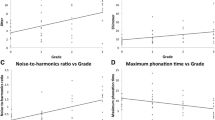Abstract
Emergence of “Voice specialty clinics” in ENT and Speech Language Pathologist (SLP) practice in India necessitates development of standard protocols for assessment and management of voice disorders. Based on recommendations from European Laryngological Society in Dejonckere (Eur Arch Otorhinolaryngol 258:77–82, 2001), a comprehensive voice assessment protocol was adapted for Indian population. This study aimed at verifying the face validity and feasibility of using the developed voice assessment protocol in a multi specialty tertiary care hospital. It included: history, clinical examination, visual analysis, perceptual analysis, aerodynamic measures, acoustic analysis and patients’ self assessment of voice. The developed protocol was administered on 200 patients with voice concerns and problems. Correlation of self assessment with the assessment by the professionals was done using Kendaul tau_b correlation test. The scores of self assessment did not correlate significantly with acoustic measures. Differences in lab findings and self percept of voice indicated that these two were complementary measures in the protocol. Further, diagnosis and management decisions were arrived through a consensus discussion involving the ENT surgeon, SLP and the patient. Vocal hygiene and voice conservation were advised to all patients. Recommendations for voice therapy and/or surgery were provided based on findings from the protocol. The study demonstrated feasibility of using a comprehensive protocol for effective documentation, comparisons, review, training and treatment planning.
Similar content being viewed by others
References
Dejonckere P, Bradeley P, Clemente P, Cornut G, Buchman LC, Friedrich G, Van De Heyning P, Remacle M, Woisard V (2001) A basic protocol for functional assessment of voice pathology, especially for investigating the efficacy of (phonosurgical) treatments and evaluating new assessment techniques. Eur Arch Otorhinolaryngol 258:77–82
Aronson AE (1990) Clinical voice disorders: an interdisciplinary approach, 3rd edn. Thieme, New York
Boone DR, McFarlane SC, Von Berg SL (2005) The voice and voice therapy, 7th edn. Pearson Education, Boston
Estella P, Edwin M (2007) Application of the ICF in voice disorders. Semi Sp Lang 28(4):343–350
Boominathan P, Rajendran A, Nagarajan R, Jayashree S, Muthukumaran G (2008) Vocal abuse and vocal hygiene practices among different level professional voice users in India—a survey. Asia Pac J Sp Lang Hear 11(1):47–53
Boominathan P, Shekar DC, Nagarajan R, Zainab M, Rajan A (2008) Vocal hygiene awareness program for professional voice users (teachers)—an evaluative study from Chennai. Asia Pac J Sp Lang Hear 11(1):39–45
Smith E, Verdolini K, Gray S (1996) Effect of voice disorders on quality of life. J Med Sp Lang Path 4(4):223–244
Hirano M, Bless DM (1993) Videostroboscopic examination of the larynx. Singilar Publishing, San Diego
Hirano M (1989) Objective evaluation of the human voice: clinical aspects. Folia Phoniatr 41:89–144
Wuyts FL, De Bodt MS, Molenberghs G et al (2001) The dysphonia severity index: an objective measure of vocal quality based on a multiparametric approach. J Speech Lang Hear Res 43:796–809
Mahalingam S, Boominathan P, Balasubramaniyan B (2010) Correlation of dysphonia severity index (DSI) and voice disorder outcome profile (V-DOP). In: Paper presented at the 4th World voice congress; 2010 Sep 6–9. Seoul, South Korea
Author information
Authors and Affiliations
Corresponding author
Rights and permissions
About this article
Cite this article
Boominathan, P., Samuel, J., Arunachalam, R. et al. Multi Parametric Voice Assessment: Sri Ramachandra University Protocol. Indian J Otolaryngol Head Neck Surg 66 (Suppl 1), 246–251 (2014). https://doi.org/10.1007/s12070-011-0460-y
Received:
Accepted:
Published:
Issue Date:
DOI: https://doi.org/10.1007/s12070-011-0460-y




